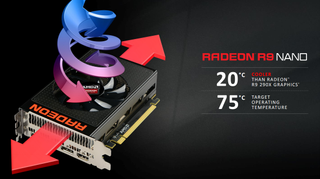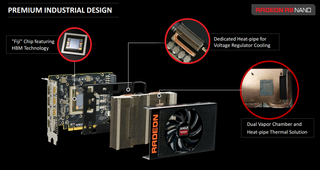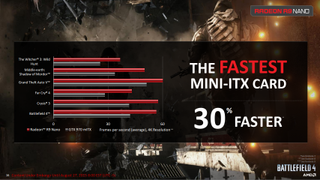Don't Call It Fury: R9 Nano Is AMD's Latest Fiji-Based Graphics Card

AMD first revealed its Fiji GPU in June at E3, showing the world the Fury X and Fury graphics cards. The company also teased a card that was much smaller and based on the same architecture. AMD has finally revealed the details of the Radeon R9 Nano, and you might be surprised by the specifications.
AMD's upcoming card is the R9 Nano. This is a Fiji based graphics card, but the company is not branding this a "Fury" card. Instead, AMD has gone with the "Nano" branding to represent how small of a footprint the new card has. R9 Nano features a tiny 6-inch long PCB, and the cooling solution is condensed within that space as well.

AMD is positioning this card as a flagship GPU designed for Mini-ITX gaming builds. Contrary to what many people have been speculating, the Nano is not a cut down version of the Fiji GPU. In fact, it features the full 4096 stream processors found in the Fury X. The main difference with this solution compared with the Fury X is that AMD has emphasized power efficiency. The Fury X was focused on maximum power, with less consideration for power consumption.
To keep the power draw limited to the rated 175 W peak, the Radeon R9 Nano adjusts the GPU clock speed for each game or application. In more demanding situations, the clock speed will drop to keep the power draw below 175 W. Less demanding applications could see the clock speed run as high as 1000 MHz, but AMD said it will more often run closer to 900 MHz. The company noted that the last 10 percent of performance comes from the last 50 percent of the power draw. As a result, AMD's engineers designed the card to be able to pinpoint the most efficient spot on the power-to-performance curve and set the clock speed dynamically for maximum efficiency.

With such a small card, you might expect the GPU to run very hot, but AMD spent significant resources on the cooling design for the R9 Nano. To cool the Fiji GPU within such a small package, the company designed a custom vapor chamber that contacts the ASIC directly and transfers heat to a set of flattened copper heat pipes, one of which is dedicated directly to the VRMs, giving them active cooling.
AMD said the flattened heat pipes allow for more fin volume within the shroud, while also keeping the heat pipes within the confines of the cooler's shroud. The fins inside the cooler are oriented horizontally across the card. AMD said this allows for 80 to 90 percent of the heat to be vented out the back of your case, especially in a positive pressure environment.

AMD claimed this vapor chamber cooler delivers performance similar to that of a water cooling solution, and as a result was able to set the card with a temperature target 20 degrees lower than what the R9 290X carried. The R9 Nano is targeted to operate at 75 degrees, though the company noted that the card won't be throttled until it peaks beyond 85 degrees.
Stay on the Cutting Edge
Join the experts who read Tom's Hardware for the inside track on enthusiast PC tech news — and have for over 25 years. We'll send breaking news and in-depth reviews of CPUs, GPUs, AI, maker hardware and more straight to your inbox.
Even with the smaller size, and cooler temperature, AMD claimed that the R9 Nano operates 16 decibels quieter than the R9 290X, as well. It features only one downward-blowing fan, but AMD has targeted 42dB as the maximum sound level, which it compared to the noise levels found in a library.

Because AMD is positioning this card as a premium option, it stuck with the high-grade materials used to construct the shroud of the R9 Fury X. The Nano features an all-black PCB, and the shroud is made of aluminum with a brushed finish. The faceplate from the Fury X was replaceable, and AMD offers a 3D file to customize and print your own. The company said it will not be releasing the same sort of file for the R9 Nano because the fan mounts directly to the cover, so it's much more complex to make.
AMD did note that it has been working with a number of water block manufacturers to create blocks for the R9 Nano, and said that overclocking the card will be possible, though the company suggested opting for the R9 Fury X for those who really want to overclock a card. The Nano is designed with power efficiency in mind, and therefore it becomes a two-step process to overclock the card: First, the power limit must be increased, which lets the GPU run at 1000 MHz in all applications. The GPU can then be overclocked, but doing this essentially makes the card a Fury X anyway. Nano is designed for those who prioritize low power draw.

Although it has water block support, AMD noted that it has no intention of unlocking the clock speed of the HBM memory of R9 Nano cards. When pressed about whether custom partner boards will be released, AMD said that we may see some custom cooling variants in Q4, but AIBs will not have the freedom to change the reference specifications of R9 Nano cards.

AMD said the R9 Nano is in a class of its own when compared to other Mini-ITX-sized graphics cards. The company claimed the performance of the Nano should be comparable to the air cooled Fury when left with its factory power limits. The next comparable GPU in this size class is the GTX 970 ITX, and AMD claimed that the R9 Nano delivers 30 percent faster performance when gaming at 4K.
AMD will release the Radeon R9 Nano in two weeks, on September 10. The company said the delay between the announcement and the release is the ramp up supply, so the R9 Nano should be available on release day.
AMD has positioned the Nano as a flagship card, and as such, the company set the MSRP of the Radeon R9 Nano at the same $649 price tag as the water cooled Fury X.
Follow Kevin Carbotte @pumcypuhoy. Follow us @tomshardware, on Facebook and on Google+.
Kevin Carbotte is a contributing writer for Tom's Hardware who primarily covers VR and AR hardware. He has been writing for us for more than four years.
-
rgd1101 30% better performance vs gtx970 for only about 100% more on price.Reply
Yup, can't wait for the review. -
salgado18 Nice card, I like it. Could pick it up instead of a Fury X, depending on how the stock perf. holds up.Reply
I still think they should drop the Radeon branding and stick to Fury, though. It's a much stronger name. -
3ogdy "In more demanding situations, the clock speed will drop to keep the power draw below 175 W" Oh great, in other words, performance will drop in more demanding situations. Of course, it will generally lose 10% of its max performance, but hey AMD finally got something right since the Fury fiasco. If it beats the GTX 970 for $650...then...RIGHT...I'll get the GTX 970 3.5GB for....that's right a whopping $300 less.Reply
http://www.newegg.com/Product/Product.aspx?Item=N82E16814121912 -
3ogdy Oh and if it beats the GTX 970 for that price, does it beat a GTX 970 SLI? Because boy can you get that for that much money, instead of a R9 FURY Nano.Reply -
justinjkiss1 This is designed for a Mini-ITX build... how would you SLI 2-970s in that build?Reply
Looks like a great card for a compact HTPC with the gaming capability -
sephirotic Whata fiasco, 649? Amd pricing of the Fury line is complete joke. Is like they deny the price and performance of the Maxwell. Come back to planet earth, AMD.Reply
All this marketing nonsense about "miniITX" does not justify the price as we have GTX 970 in mini itx form at 350USD.
AMD is disappointing everyone, first the shameless re-branding, now, a 10 months late release compared to Maxwell, less efficient and more expensive without actually delivering performance. We need competition for Intel and NVIDIA urgent, but the way AMD is presenting a fiasco after fiasco, we're just a couple of years to see the market become a monopoly.
Most Popular



